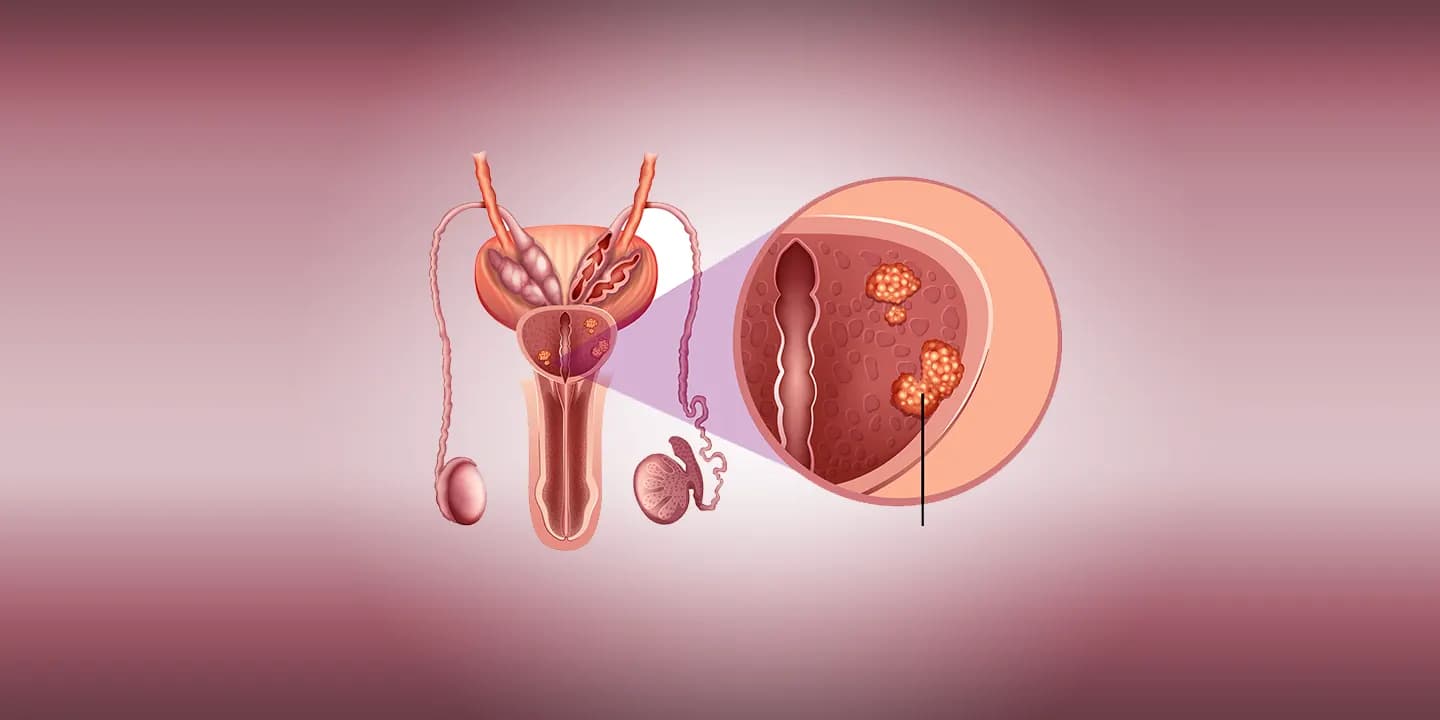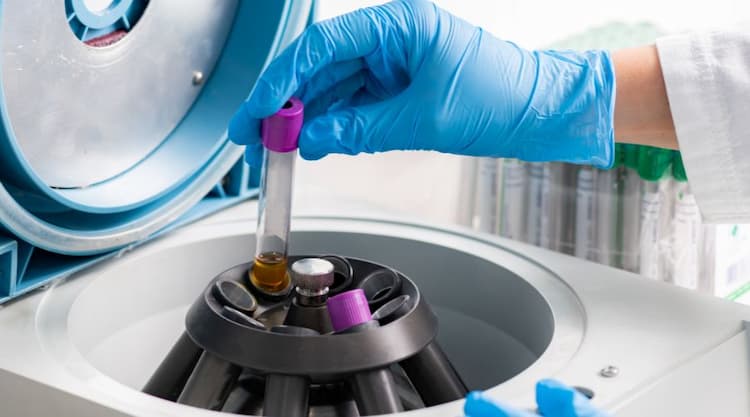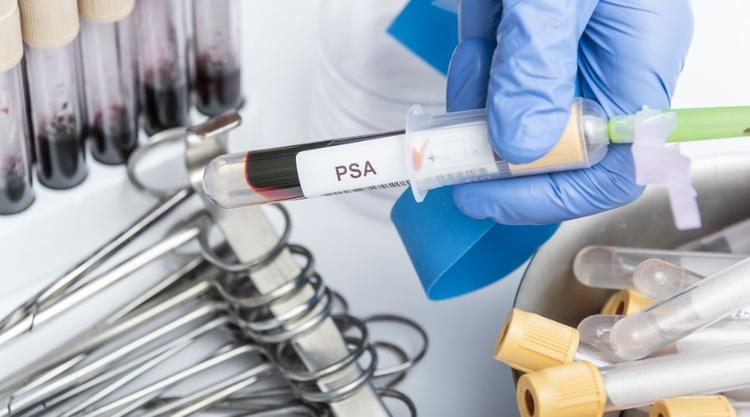Prostate Cancer: symptoms, causes, and treatment

Medically Reviewed By
Dr. Ragiinii Sharma
Written By Prekshi Garg
on May 17, 2022
Last Edit Made By Prekshi Garg
on Mar 17, 2024

According to worldwide reports, prostate cancer accounts for approximately 7.1% of all the types of cancer reported in men. Around 36 men out of 100,000 are diagnosed with prostate cancer every year. Although it is a prevalent type of cancer, prostate cancer is treatable if diagnosed early.
The prostate accounts for multiple reproductive and general health functions in men. The fluid secreted by the prostate is responsible for nourishing and transporting sperm through the male reproductive tracts. Besides reproductive functions, the prostate is also responsible for supporting urine control and function.
Given the prevalence of prostate cancer, knowing the different aspects, including the causes and symptoms, can support the prompt diagnosis and better recovery. We will discuss all of that in detail in this guide.
[wptb id=6961]
In this Article
What is Prostate Cancer?
The prostate is a small, walnut-shaped gland anatomically placed in between the penis and the bladder of a male individual.
The gland, as mentioned, produces the seminal fluid, which is responsible for nourishing and transporting the sperm through the reproductive tract.
Prostate cancer is the growth and development of cancerous cells in the small gland present in the male reproductive system. The majority of prostate cancer diagnosis is treated with the “wait and watch” method since the growth and spread of the cancer is confined to the gland and progresses at a prolonged rate.
In other cases, prostate cancer could be highly aggressive and require assistive hormonal or non-hormonal treatment options, including chemotherapy, radiation, immunotherapy, etc. The type of prostate cancer confined to the gland and gets an early diagnosis has a quicker and more successful chance of recovery.
What are the Symptoms of Prostate Cancer?
Like most other cancers, even prostate cancer might not show significant signs and symptoms in the earlier stages. However, if you are at risk of developing prostate screening, getting timely and early screening can account for an early diagnosis if you are at risk of developing prostate screening.
The prostate, which is responsible for producing prostate-specific antigen (PSA), a type of protein that enables the semen to stay in a liquid state, is a critical marker in diagnosing prostate cancer.
Some of the common prostate cancer symptoms that could indicate a possibility of prostate cancer are:
- Issues with the urination frequency and force
- Frequent urge to urinate (especially at night)
- Blood discharge in the urine
- Painful urination
- Painful ejaculation
- Pain in the back
- Bone pain
- Unexpected weight loss
- Erectile dysfunction
Remember that these symptoms aren’t a definitive sign of prostate cancer. However, your doctor will consider these symptoms before prescribing further tests to confirm their suspicions.
What are the Causes of Prostate Cancer?
Despite being one of the most common types of cancers in men, researchers are still unable to find a definitive cause that contributes to it. However, a few studies indicate that mutations and changes in the glandular cells in the prostate contribute to the uncontrolled cancerous cell growth in the prostate.
The incidence of prostatic intraepithelial neoplasia (PIN) is a marker of prostate cancer. However, it doesn’t always contribute to cancerous growth. Sometimes, the prevalence of PIN is also noticed in individuals with an enlarged prostate gland.
However, although there are not many definitive prostate cancer causes, a few notable risk factors are worth considering.
Aging – men over the age of 50 are at heightened risk of having prostate cancer. The prevalence of prostate cancer is quite rare in men under 45.
Ethnicity – black people are at maximum risk of developing prostate cancer, followed by Asian, Hispanic, and Caucasian men. Also, the state of prostate cancer in Black men is a lot more aggressive compared to other races.
Genetic predisposition – familial history of prostate cancer often heightens the risk of getting prostate cancer later in life. Although surprising, a prevalent medical history of breast cancer in the family can contribute to heightened risks of prostate cancer in the next-generation males in the family. It is due to the mutations in BRCA1 or BRCA2 genes.
Obesity – being overweight or obese are contributing risk factors to the development of prostate cancer. Although the studies aren’t conclusive yet, a few studies highlight that obese men are at risk of developing a more aggressive type of prostate cancer than a man with a healthy weight.
Diet – a high-fat diet is again directly associated with higher risks of prostate cancer in men.
Unhealthy habits – poor lifestyle habits like smoking and alcohol are also associated with the risks of developing prostate cancer in men.
What are the Stages of Prostate Cancer?
Assessing the stage of prostate cancer is ideal to understand the severity of cancer and whether or not it is localized to the gland or has started metastasizing to the other vital organs.
In prostate cancer, the condition is divided into four stages:
Stage I – localized to the prostate gland.
Stage II – although localized to the prostate gland, the PSA levels are incredibly high.
Stage III – cancer has started spreading to the adjacent reproductive organs and tissues.
Stage IV – cancer has metastasized to the vital organs in the body.
The fourth stage is generally the fatal stage. The doctor will either suggest palliative care to reduce the pain and support the patient's quality of life or suggest non-hormonal treatment options as a last resort to control the further spread of cancer.
How is Prostate Cancer Diagnosed?
Once you start noticing unpleasant and recurring symptoms, book a doctor’s consultation to assess the complications. During the appointment, your doctor will start the symptoms and the duration of the same. How long how have you been experiencing these symptoms?
Besides that, your doctor will also ask for a medical history of you and your family to assess hereditary risks of prostate cancer. Depending on the above discussion, your doctor will then move to the diagnostic testing.
There are two important markers in the prostate screening test:
Prostate-specific antigen (PSA) test – this analyzes the levels of PSA in the bloodstream. PSA is naturally produced by the prostate to maintain the fluid nature of the semen. An uncontrollably high level of PSA in the blood is generally a sign of infection or inflammation in the prostate and, in severe cases, prostate cancer.
Digital rectal exam (DRE) – this is a physical prostate examination where the doctor inserts a gloved and lubricated finger through the patient's rectum to assess the prostate health. If the doctor finds abnormalities in the prostate's size, hold, and texture, they will prescribe further screening.
Besides the initial stages of prostate screening, there are a few other diagnostic measures that offer a confirmed diagnosis. They are:
Imaging tests – both ultrasound and MRI help get an in-depth look into the patient’s prostate to check for abnormal and unwanted cell mass and tumor growth. If the growth is incredibly large and requires a further biopsy, an MRI can generate a much clearer vision for the doctor to plan their sample collection process for biopsy.
Biopsy – the last stage to confirm a diagnosis for prostate cancer is through biopsy. The procedure is done by extracting a small collection of tissue from the prostate to analyze whether it is cancerous and examines cancer's severity.
Since most types of prostate cancer are diagnosed at a treatable stage, your doctor still needs to confirm the degree of aggressiveness of the cancerous cells. There are two types of screening that help with that, including:
Following a confirmed diagnosis of prostate cancer, the next stage of diagnosis is to determine the cancer stage. This is done via:
- Bone scan
- Ultrasound
- PET scan
- MRI or CT scan
The number of tests for prostate cancer you need for a confirmed and comprehensive diagnosis depends on your doctor. They will assess the extent of the disease and prescribe the tests that will enable them to come up with a comprehensive treatment plan.
What are the Treatment Options for Prostate Cancer?
As mentioned before, prostate cancer treatment doesn’t always start immediately after a diagnosis. Generally, your doctor will first assess the extent of the spread of cancer and its aggressiveness before getting you on a treatment regimen.
Low-grade Prostate Cancer Treatment
Low-grade prostate cancer is when the cancer cells are localized to the gland and proliferate at a prolonged rate. In such cases, your doctor will suggest being under active surveillance. The patient needs to get frequent testing every few months to assess how far cancer has progressed.
Surgical Treatment
If a patient’s prostate cancer is confined to the gland, radical prostatectomy is a surgical intervention many doctors suggest. This enables the patient to get rid of the tumor from the gland. It also involves the excision of the affected lymph nodes in the surrounding areas. Surgical options are also ideal for patients with aggressive prostate cancer, which will metastasize if not removed immediately.
Hormonal Treatment
The prevalence of excess testosterone in the body helps treat prostate cancer. The prostate cancer cells feed off the testosterone to grow, develop and increase the patient’s body. So, hormonal treatments target testosterone production in the body and inhibit it. Some of the most common hormone treatments for prostate cancer include gonadotropin-releasing hormone (GnRH) agonists and antagonists, anti-androgens, etc. These shrink the cancer cells and delay their growth.
Radiation Therapy
A choice between external beam radiation or brachytherapy can help treat an aggressive form of prostate cancer. This is a non-hormonal type of treatment usually prescribed in patients with an aggressive form of prostate cancer. Besides that, cryoablation, cryotherapy, or high-intensity focused ultrasound (HIFU) treatment is also used to treat prostate cancer.
Chemotherapy
A prevalent form of cancer treatment, chemotherapy uses a combination of chemicals and drugs injected into the patient’s body through an intravenous route to kill the cancerous cells in the prostate or where cancer has metastasized to. Chemotherapy is used for non-localized prostate cancer or patients who aren’t responding to hormone therapy.
Immunotherapy
The last and one of the most potent prostate cancer treatments is immunotherapy. This triggers the body’s immune system to identify the cancer cells as foreign agents and kill them. Immunotherapy interferes with the cancerous cell’s ability to hide from the body’s T-cells. Hence, it engineers the body’s T-cells to identify the cancerous cells and kill them.
Can Prostate Cancer be Prevented?
The risks of prostate cancer can be managed and reduced with substantial lifestyle changes. Some include:
Eating a healthy and balanced diet – including vitamin and mineral-rich fruits and vegetables- reduces prostate cancer risks.
Avoid supplements – most store-bought supplements aren’t always FDA regulated, leaving room for underlying complications. So, instead of relying on supplements, focus on eating a healthy and balanced diet.
Maintain an active lifestyle – since overweight and obese individuals are at higher risks of prostate cancer, switching to an active lifestyle can help avert those risks.
Get early screening – if you have a familial medical history of prostate cancer, discuss the same with your primary care physician to get routine prostate screening. This enables to reduce the risks or get an earlier diagnosis.
Frequently Asked Questions
-
Can prostate cancer be cured?
With an early diagnosis and proper treatment regimen, prostate cancer can be cured with different hormonal and non-hormonal treatment options.
-
How can one test for prostate cancer at home?
There are at-home PSA tests available in the market. If you are experiencing likely symptoms of prostate cancer, you can opt for the self-testing kits as a first resort before seeing a doctor.
-
How fast does prostate cancer spread?
Most types of prostate cancer progress very slowly. Some types of prostate cancer can take up to 15 years to spread from the prostate to other parts of the body. Your doctor will advise active surveillance with regular screening to assess the degree of spread.
Conclusion
Prostate cancer has a very high recovery rate with timely diagnosis and a targeted treatment regimen. If you are at risk of developing prostate cancer, get timely screening for an early diagnosis. Especially if you are above 45, getting routine screening should be part of a general health check-up. The earlier the diagnosis, the more effective the treatment is.




![Gluten Allergy Test - Price, Purpose, & Result [2024]](/myhealth/_next/image/?url=https%3A%2F%2Fmyhealth-redcliffelabs.redcliffelabs.com%2Fmedia%2Fblogcard-images%2FNone%2Fe94dfe46-8720-40de-854a-deedae3143d1.webp&w=750&q=75)
